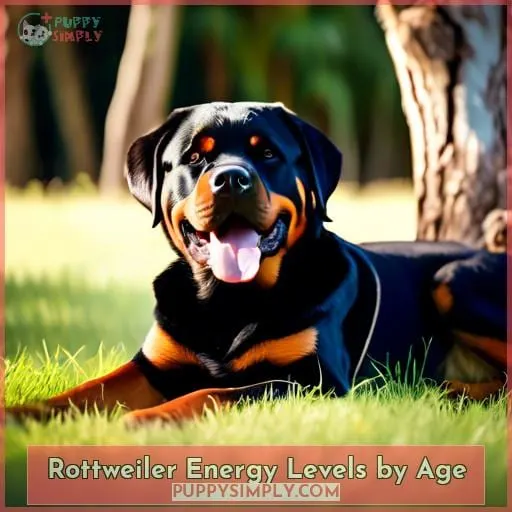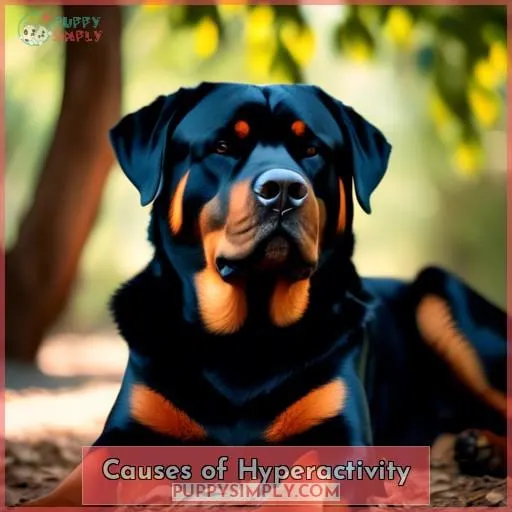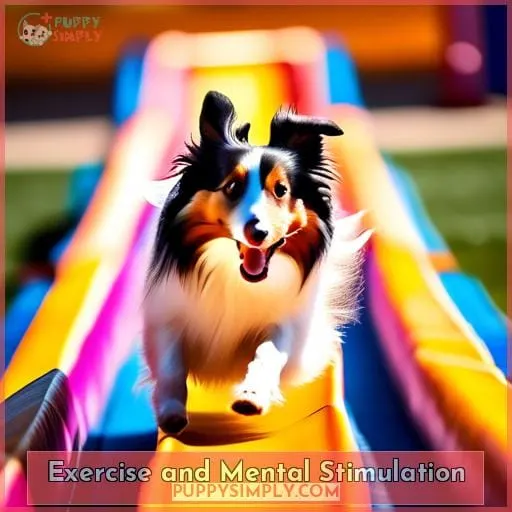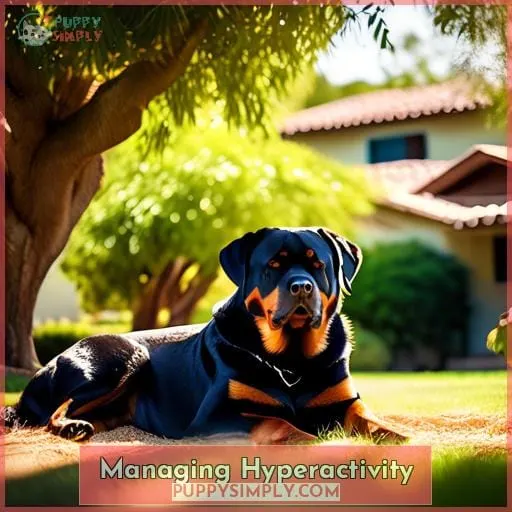This site is supported by our readers. We may earn a commission, at no cost to you, if you purchase through links.
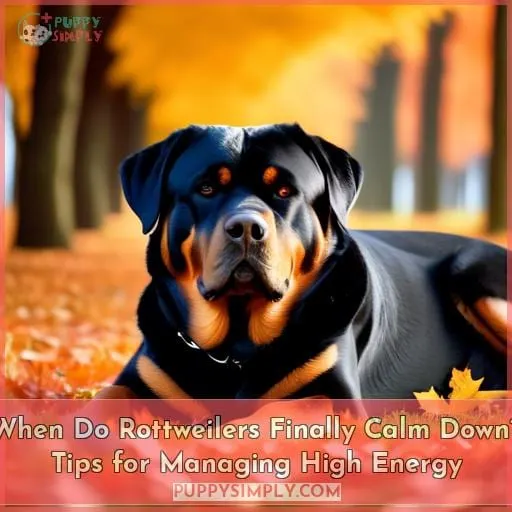 Wondering when your Rottweiler will start to settle down?
Wondering when your Rottweiler will start to settle down?
Typically, these robust canines begin to mellow around the 24-month mark.
But don’t expect an overnight transformation; it’s a gradual process influenced by factors like exercise, training, and individual temperament.
Your Rottweiler’s boundless energy can be managed with consistent physical activity and mental challenges, ensuring they mature into a well-behaved companion.
Stay tuned for tips on harnessing that Rottweiler vigor and fostering a serene environment for you and your furry friend.
Table Of Contents
- Key Takeaways
- Rottweiler Energy Levels by Age
- Calming Down Timeline
- Causes of Hyperactivity
- Exercise and Mental Stimulation
- Training and Socialization
- Managing Hyperactivity
- When to Seek Help
- Frequently Asked Questions (FAQs)
- At what age can I start obedience training with my Rottweiler puppy?
- How much exercise does an adult Rottweiler need per day?
- What types of mental stimulation toys are best for keeping my Rottweiler engaged?
- Is it normal for my 2 year old Rottweiler to sometimes ignore commands he knows well?
- My 4 year old Rottweiler still gets very excited and jumpy when we have visitors. What can I do?
- Conclusion
Key Takeaways
- Rottweilers start to gradually calm down around age 2 years, though the process is influenced by training, exercise, and inherent temperament.
- Patience, consistency in training, and providing positive reinforcement are important for managing high energy levels common in Rottweiler puppies and adolescents.
- Appropriate outlets like exercise, agility training, and mental stimulation can help channel excess energy and promote calmness.
- Factors like genetics, fears, lack of training, or medical issues may contribute to prolonged hyperactive behaviors requiring additional behavioral interventions.
Rottweiler Energy Levels by Age
As a Rottweiler owner, you can expect your puppy to have boundless energy in the first two years of life before settling down in adulthood from age 2 to 8.
Around 8 years old, Rottweilers transition into their senior years, which comes with lower energy levels overall and a preference for longer naps and more leisurely activities.
Understanding what to expect as your Rottweiler ages will help you provide age-appropriate exercise and stimulation.
Puppyhood (0 – 24 Months)
As a Rottweiler owner, you’ll face endless energy during your pup’s first two years of ceaseless activity and boisterous behavior.
During puppyhood, establish training, exercise, and routines early to channel their natural exuberance positively.
Use puppy training for impulse control, provide plenty of walks and play for physical outlets, and use mental games for stimulation.
Proper socialization and exposure during this high energy but impressionable time will pay dividends with a well-adjusted, obedient dog in adulthood.
Adulthood (2 – 8 Years)
Frequently, you’re surprised to find your Rottweiler remains energetic during adulthood, despite expectations they’d calm by age two.
Consider health factors like thyroid levels along with dietary adjustments to meet energy demands.
Environmental enrichment through physical and mental stimulation curbs hyperactivity tendencies.
Relaxation techniques reinforce calm behavior while behavioral modifications address temperamental causes for prolonged energy.
Seniors (8 Years +)
When your Rottweiler reaches eight years old and beyond, you’ll notice their energy levels start to decrease significantly.
Aging Rottweilers require adjustments to their senior care like more rest, shorter walks, and attention to any emerging health issues.
Keep them mentally and physically engaged through training games and low-impact activities.
But respect their elderly behavior and don’t push them too hard.
With compassion and vigilance for their geriatric needs, you can support your Rottie into their later years.
Calming Down Timeline
As a Rottweiler owner, you’ve likely experienced the high energy intensity of a Rottweiler puppy.
Typically, Rottweilers start to calm down around 24 months of age, though the exact timeline depends on several factors.
Managing a high energy Rottweiler requires patience, training, and providing appropriate physical and mental stimulation.
Initial High Energy
How’d Rottweilers exhibit incredibly high energy levels initially before gradually settling down around age two?
You’ll often see them bouncing off the walls as puppies and adolescents unless properly trained and exercised.
Establishing a puppy playtime and exercise regimen tailored to energetic breeds is crucial during this phase, as is providing ample mental stimulation through training, games, and socialization techniques.
Meeting their needs at a young age paves the way for a well-adjusted adult Rottweiler.
Gradual Calming (24 Months)
You’d notice your Rottweiler transitioning into calmer behavior around the two-year mark, according to experts.
Expect gradual adjustments in canine relaxation as behavioral interventions reinforce patience and consistency.
Manage expectations through long-term training focused on:
- Understanding the breed’s needs
- Building trust
- Channeling energy positively
Factors Influencing Calmness
Factors Influencing Calmness:
- Genetic Predisposition to High Energy Levels: Some Rottweilers may have a genetic predisposition to high energy levels, making them more prone to restlessness and excitability.
- Access to Outlets Like Agility Courses: Providing your Rottweiler with access to outlets like agility courses, fetch games, or interactive toys can help channel their energy and promote calmness.
- Consistency with Training Techniques: Consistency in training techniques is crucial for establishing a calm and obedient Rottweiler. Using positive reinforcement methods and maintaining a consistent routine can help reinforce desired behaviors and reduce anxiety.
- Appropriate Exercise Regimen: An appropriate exercise regimen is essential for managing your Rottweiler’s energy levels and promoting calmness.
Causes of Hyperactivity
You may find your Rottweiler remains hyperactive even after reaching maturity.
Lack of exercise, poor training, underlying fears, and insecurities are common culprits that contribute to ongoing high energy behaviors.
Addressing these root causes is essential to help your Rottweiler finally calm down.
Lack of Exercise
You often see hyperactivity in Rottweilers when they don’t get enough physical activity on a regular basis.
Without outlets for their energy, Rottweilers can become restless and bored, leading to destructive behaviors.
Provide daily exercise through walks, playing fetch, or engaging in physically and mentally stimulating activities.
Seek alternatives like obedience training, agility courses, or interactive toys when weather limits outdoor time.
Meeting their needs for exercise prevents pent-up energy from manifesting as hyperactivity.
Poor Training
You’ll also find that inadequate or inconsistent training can lead to ongoing hyperactivity in Rottweilers.
Behavioral modification through positive reinforcement shapes behaviors.
Using consistent training techniques derived from canine psychology principles positively impacts conduct.
Communicating effectively per established learning principles cements good habits.
Accountability and repetition anchor training for the sensitive Rottweiler psyche.
Fears and Insecurities
Through poor training or lack of socialization, you risk your Rottweiler developing fears and insecurities that manifest as hyperactive behaviors.
Easing fears and overcoming anxieties in your Rottie requires addressing underlying phobias.
Confidence-building exercises like treat rewards for tolerating stimuli help, as does slow exposure paired with affection.
| Cause | Symptom | Solution |
|---|---|---|
| Loud noises | Barking, hiding | Desensitization |
| Strangers | Growling, lunging | Positive exposure |
| Separation | Destructive chewing | Crate training |
Exercise and Mental Stimulation
As energetic dogs, rottweilers need daily vigorous physical activity and mental challenges to stay calm and prevent destructive behaviors.
Establish a consistent routine that includes:
- Long walks
- Playtime
- Interactive games
to stimulate their mind and body.
Meeting their needs for exercise and mental stimulation is key to managing their high energy, especially when they’re young.
Daily Physical Activity
One way to manage a hyperactive Rottweiler is to provide at least 60 minutes of vigorous exercise daily, along with mental stimulation through training, games, and social interaction.
- Outdoor adventures like hiking, running, or agility courses.
- Indoor playtime with interactive toys.
- Mental challenges through advanced obedience training.
- Routine exercises tailored to the individual dog’s needs.
Mental Challenges
In addition to physical activity, you’re wise to give your Rottweiler mental challenges.
Like obedience training or puzzle toys to stimulate their mind and help manage hyperactivity.
Mental engagement through cognitive challenges provides needed intellectual exercises to occupy an energetic dog’s brain.
Try stimulating activities like obedience courses, tracking games, or even DIY brain teasers to tap into their intelligence and curb problematic behaviors.
Importance of Routine
You’ll find sticking to a routine of physical activity and mental stimulation keeps hyperactivity at bay in Rottweilers.
Establishing consistent daily rituals and structured routines with regular exercise, training, playtime, and affection meets their needs for activity, while providing predictable patterns that reduce anxiety.
Adhering to these established habits and schedules channels their energy positively.
Training and Socialization
You’ll want to begin training and socialization early, starting around 6 weeks old.
Establish yourself as the authority figure and prevent problem behaviors.
Focus first on basic obedience commands like sit, stay, and heel before expanding training into more advanced areas over time.
It’s also essential to socialize your Rottweiler puppy with a wide variety of people and animals to prevent fear or aggression issues from developing.
Starting Early
Starting puppy training and socialization early on is essential for having a well-mannered Rottweiler.
Establish good habits through positive reinforcement training at 6-8 weeks old to influence behavioral development.
Prioritize basic obedience like sit, stay, come, and heel to provide structure.
Arrange supervised interactions with people and other animals for exposure.
Be a dedicated leader to guide appropriate play and set boundaries.
Basic Obedience Commands
After learning sit, stay, come, down, heel, and other easy obedience commands from 6 weeks old, you’ll have a Rottweiler that better responds to direction.
Incorporate basic obedience training early using positive reinforcement to establish good manners and cues for social interactions.
Consistent, patient training reinforces techniques for a well-behaved companion.
| Command | Purpose |
|---|---|
| Sit | Teaches patience and self-control. |
| Stay | Develops impulse control. |
| Come | Recalls your dog to you. |
| Down | Calms an excited dog. |
| Heel | Enforces good leash manners. |
Socialization With People and Animals
Early socialization with both people and other animals helps prevent fear and aggression in your Rottweiler later in life.
Expose your puppy to different people, environments, and friendly dogs through canine companionship programs.
This social integration during the prime bonding window strengthens interspecies relationships, facilitating human bonding and preventing stranger anxiety down the road.
Frequent positive animal interaction ensures your Rottweiler becomes a well-adjusted, socialized dog.
Managing Hyperactivity
- Focus on professional training options.
- Reward calm behavior.
- Avoid negative reinforcement.
- Consult with vets or animal behaviorists for personalized advice.
- Rewarding calmness reinforces the right behaviors.
- Punishment tends to exacerbate the problem.
- Stay positive and be patient.
- Address any underlying issues.
Professional Training Options
While professional training options can help manage hyperactivity in Rottweilers, you’re wise to begin by:
- Rewarding calm behavior.
- Avoiding negative reinforcement such as scolding or punishment, as these can often exacerbate hyperactive tendencies rather than resolving them.
Consider personalized coaching with dog behavior experts, group obedience classes, or online courses for targeted support.
Just be sure the training is positive and tailored to your Rottweiler’s unique needs.
Rewarding Calm Behavior
Two can reinforce desired calmness in Rottweilers by rewarding them during periods of relaxed behavior.
Here are three relaxation techniques to try:
- Use behavioral incentives like treats or toys to positively reinforce calm behavior.
- Reduce stress and anxiety through tranquil reinforcement during serene moments.
- Provide encouragement through soothing pets or praise during periods of calmness.
Avoiding Negative Reinforcement
Although using negative reinforcement like scolding or physical punishment may seem like an easy way to curb unwanted behaviors, you’ll get better results by avoiding those tactics, which can actually make the problem worse.
Focus on positive reinforcement and reward-based training instead, gently correcting and encouraging good behavior.
This builds trust and teaches your Rottweiler what you want them to do.
When to Seek Help
If your adult Rottweiler continues displaying hyperactive or problematic behaviors, it may be time to seek professional help.
Persistent hyperactivity after maturity or new behavioral issues could indicate underlying medical conditions or psychological problems that require an expert opinion.
Consulting a veterinarian, certified dog trainer, or animal behaviorist can provide indispensable guidance on managing high energy dogs like Rottweilers.
Persistent Hyperactivity
If your Rottweiler remains hyperactive despite daily exercise and training, consult a professional to address any underlying behavioral or medical issues.
Assess triggers like loud noises or stressful environments.
Look into behavioral interventions like desensitization training.
Enrich the environment with more toys and activities.
Try techniques to reduce stress and anxiety.
Medication may help in some cases if behavioral methods fail.
Behavioral or Medical Issues
You’ll want to consult a professional if your Rottweiler’s hyperactivity persists despite your best efforts or if there are other concerning behavioral or medical issues.
Issues to Consider:
- Anxiety disorders
- Compulsive behaviors
- Pain or illness
- Hormonal imbalances
- Genetic factors
Treatment Options:
- Behavioral therapy
- Veterinary consultation
- Diagnostic evaluation
- Medication options
- Holistic approach
Consulting a Professional
You should schedule an appointment with a veterinarian or animal behavior professional if your Rottweiler’s hyperactivity persists despite your best efforts.
Seek professional guidance for behavioral analysis and therapy.
Consult specialists like veterinarians, trainers, or behaviorists for expert assistance.
Get help determining if underlying medical issues are causing the hyperactivity.
Frequently Asked Questions (FAQs)
At what age can I start obedience training with my Rottweiler puppy?
At 6 weeks old, you can begin obedience training your Rottweiler puppy.
Use positive reinforcement like treats and praise to teach basic commands.
Be patient, training in short sessions to account for their short attention span.
Stay consistent with rules and patience.
How much exercise does an adult Rottweiler need per day?
An adult Rottweiler needs at least an hour of vigorous exercise per day to stay healthy and calm.
More exercise unleashes their energetic spirit.
Mix activities like running, hiking, and active games to fully stimulate their mind and body.
Consistency builds an unbreakable bond.
What types of mental stimulation toys are best for keeping my Rottweiler engaged?
Try puzzle toys like treat-dispensing balls to keep your Rottweiler mentally stimulated.
Rotating different puzzles prevents boredom.
Snuffle mats for hiding treats also encourage natural foraging behavior.
Just be sure to monitor playtime to avoid overeating.
Frequent but shorter mental challenges work best for this energetic breed.
Is it normal for my 2 year old Rottweiler to sometimes ignore commands he knows well?
Yes, it’s normal for a 2-year-old Rottweiler to sometimes ignore commands.
They’re still young and impulsive.
Reinforce training with patience, consistency, and rewards.
Meet their needs for exercise and stimulation.
If problems persist, seek professional advice.
My 4 year old Rottweiler still gets very excited and jumpy when we have visitors. What can I do?
Stay calm and use positive reinforcement when visitors arrive.
Redirect your Rottweiler’s energy into a sit or down command.
Then reward the calm behavior with praise or treats.
Consistency builds good habits over time.
Conclusion
With your Rottweiler’s boundless energy, you may feel overwhelmed at times.
But remember – this too shall pass.
As your pup matures, consistency, training, and outlets for physical and mental stimulation will help harness that vigor into a more settled companion.
Have patience, young grasshopper.
With time, effort, and understanding, your energetic pup will blossom into the calm, loyal friend you’ve been dreaming of.

